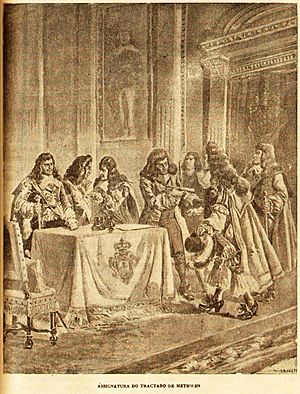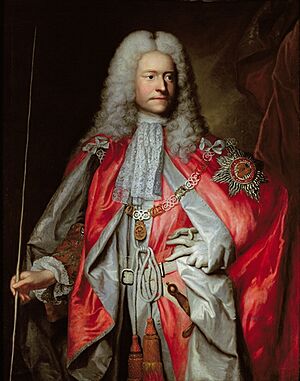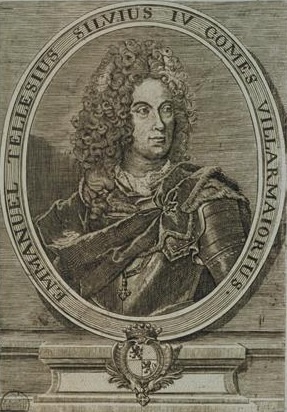Methuen Treaty facts for kids
The Methuen Treaty was an important agreement signed in 1703 between England (now part of the United Kingdom) and Portugal. It was both a military deal and a trade agreement, made during a big conflict called the War of the Spanish Succession.
This treaty said that Portugal's wines, when sold to England, wouldn't be taxed more than French wines. In return, English cloth and fabrics sent to Portugal wouldn't have any taxes at all. This was meant to help trade between the two countries, even if they weren't always allies in wars.
The treaty had both good and bad effects. A downside for Portugal was that it didn't develop many new industries, like factories, as much as it could have. It focused a lot on wine. On the good side, the treaty helped Portugal keep its power in Europe. It also helped protect its most important colony, Brazil, from other countries.
Why the Treaty Happened
When the War of the Spanish Succession began, Portugal was allied with France. France had promised to protect Portugal's navy. However, in 1702, the English navy sailed near Lisbon. This showed Portugal that France couldn't keep its promise. Soon after, Portugal started talking with the Grand Alliance about changing sides.
There were actually two Methuen Treaties. Both were negotiated for England in Lisbon by John Methuen. He was an important English diplomat. His son, Sir Paul Methuen, also helped.
The first treaty was a military alliance signed in May 1703. It decided which countries would be allies in the war. This treaty involved England, Portugal, the Holy Roman Empire, and the United Provinces (Netherlands).
The second treaty, signed in December 1703, was the more famous trade agreement. John Methuen signed it for England. Manuel Teles da Silva, 3rd Marquis of Alegrete signed it for Portugal.
At the start of the war, fighting in Flanders (modern-day Belgium) wasn't going well. Some English leaders thought that naval warfare was a better and cheaper option. Portugal had deep-water ports near the Mediterranean Sea. These ports were perfect for fighting against the French navy based at Toulon.
What the Treaty Did
The Methuen Treaties had three main parts. First, they set the goals for the Grand Alliance in the war. Second, they made Spain a new main area for fighting. Finally, they set up trade rules, especially between England and Portugal.
Before 1703, the Grand Alliance didn't have clear war goals. The Methuen Treaties changed this. They confirmed that the alliance would try to get the entire Spanish Empire for Charles of Austria. He was the Habsburg family's choice to be the next king of Spain.
The first treaty also decided how many soldiers each country would send to fight in Spain. Portugal also insisted that Archduke Charles himself should come to Portugal. This was to make sure all allies were fully committed to the war in Spain.
The second treaty, signed on December 27, 1703, is often called the "Port Wine Treaty." It helped create trade rules between England and Portugal. The rules allowed English wool cloth to enter Portugal without any taxes. In return, Portuguese wines imported into England would have much lower taxes than wines from France.
This was very important for the port industry in Portugal. England was at war with France, so it was hard to get French wines. Because of this, port wine became a popular replacement in England.
Experts like Cypher and Dietz have noted that Portugal focused on wine. This product didn't have as much growth potential as England's cloth industry. Portugal's economy suffered because it focused so much on wine. After the treaty, Portugal often bought more from England than it sold. Luckily, a gold rush in Brazil helped Portugal pay for its imports for a while. However, the long-term benefits of this trade deal were not as great for Portugal.




